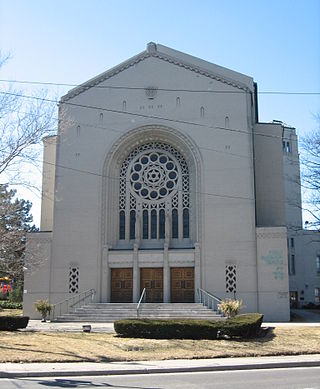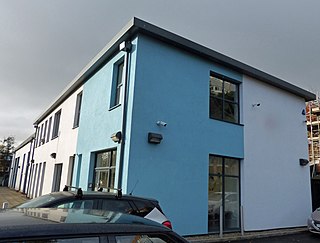
The Holy Blossom Temple is a Reform synagogue located at 1950 Bathurst Street in Toronto, Ontario, Canada. It is the oldest Jewish congregation in Toronto. Founded in 1856, it has more than 7,000 members. W. Gunther Plaut, who died on 8 February 2012 at the age of 99, was a long time Senior Rabbi for this synagogue. Notable members and supporters include Heather Reisman and Gerald Schwartz who made donations to create the Gerald Schwartz/Heather Reisman Centre for Jewish Learning at Holy Blossom Temple.

Captain George Taylor Denison was a British-born landowner, military officer and community leader in Upper Canada.
Anshei Sfard is an Orthodox congregation and synagogue located at 2904 Bardstown Road, in Louisville, Kentucky, in the United States. Affiliated with the Orthodox Union, the synagogue offers Shabbat and Yom Tov services. Prayer services are conducted in Nusach Ashkenaz.

Breed Street Shul, also known as Congregation Talmud Torah of Los Angeles or Breed Street Synagogue, is a former Orthodox Jewish synagogue in the Boyle Heights section of Los Angeles, California, in the United States. It was the largest Orthodox synagogue west of Chicago from 1915 to 1951, and is listed in the National Register of Historic Places.
RodephShalom, may refer to:
Anshe Sholom B'nai Israel is a Modern Orthodox Jewish congregation and synagogue located at 540 West Melrose Street, in the Lakeview neighborhood on the north side of Chicago, Illinois, in the United States.
Synagogues may be considered "oldest" based on different criteria, and can be oldest in the sense of oldest surviving building, or oldest in the sense of oldest congregation. Some old synagogue buildings have been in continuous use as synagogues, while others have been converted to other purposes, and others, such as the Touro Synagogue, were shuttered for many decades. Some early established congregations have been in continuous existence, while other early congregations have ceased to exist.

The Birmingham Central Synagogue is an Orthodox Jewish congregation and synagogue, located at 4 Speedwell Road in Edgbaston, Birmingham, in the West Midlands region of England, in the United Kingdom. The congregation, established in 1894, worships in the Ashkenazi rite.
First Narayever Congregation is a traditional-egalitarian synagogue located at 187 Brunswick Avenue, in the Harbord Village neighbourhood of Toronto, Ontario, Canada. It is the largest Jewish congregation in downtown Toronto. It was founded by the Jewish immigrants from Narayiv, western Ukraine, hence the Yiddish name "Narayever".
Toronto's Jewish community is the most populous and one of the oldest in the country, forming a significant part of the history of the Jews in Canada. It numbered about 240,000 in the 2001 census, having overtaken Montreal in the 1970s. As of 2011, the Greater Toronto Area is home to 188,710 Jews. The community in Toronto is composed of many different Jewish ethnic divisions, reflecting waves of immigration which started in the early 19th century. Canada's largest city is a centre of Jewish Canadian culture, and Toronto's Jews have played an important role in the development of the city.

Congregation Knesseth Israel, also known as the Junction Shul, is an Orthodox Jewish congregation in Toronto, Ontario, Canada. Its synagogue building is the oldest surviving in Toronto that is still in use, and was designated an Ontario Heritage site in 1984 under the Ontario Heritage Act.

Anshei Minsk is a synagogue in the Kensington Market neighbourhood of Toronto, Ontario, Canada. It was founded in 1912 by poor Jewish immigrants from what is now Belarus, which at the time was part of the Russian Empire. The current Byzantine Revival building was completed in 1930.
Shaarei Tzedec Congregation is an Orthodox Jewish synagogue located at 397 Markham Street in Toronto, Ontario, Canada.
The Beach Hebrew Institute, also known as Beth Jacob Congregation, is a Conservative Jewish congregation and synagogue, located in The Beaches neighbourhood of Toronto, Ontario, in Canada. Founded in 1919 as an Orthodox Jewish congregation, the members purchased their current building—a former church—in 1920, and renovated it in 1926.
Shaarey Tphiloh is a Modern Orthodox Jewish congregation and synagogue located at 400 Deering Avenue, in Portland, Maine, in the United States. The congregation claims it is the oldest continuously operating synagogue in Portland. The name of the synagogue literally means "Gates of Prayer" in Hebrew.

Anshei Sphard Beth El Emeth Congregation, abbreviated as ASBEE, was an Modern Orthodox synagogue located at 120 North East Yates Road, in East Memphis, Tennessee, in the United States. Established in 1966, with a history dating from 1861, the congregation operated for over 160 years prior to its 2023 merger with the Baron Hirsch Congregation.
The Great Park Synagogue is an Orthodox synagogue situated in Houghton, Johannesburg. The present building was consecrated in 2000, after the congregation vacated their long-time home, the Great Synagogue on Wolmarans Street, Hillbrow in 1994, after eighty years. The Wolmarans Street synagogue came to be known as the city's mother synagogue and "the crown jewel of Orthodox Judaism in South Africa." All large-scale Jewish events in Johannesburg were held in the building, and throughout its existence it was the seat of the country's chief rabbi. Northward migration by congregation members led to the synagogue closing its doors in 1994. The relocated synagogue was built on the model of the Great Synagogue, whose own architecture in turn was inspired by the Hagia Sophia. Great Park Synagogue was also the original name of the synagogue on Wolmarans Street before it became the Great Synagogue.

Beth Jacob V’Anshei Drildz is an Orthodox synagogue in the North York district of Toronto, Ontario, Canada. Founded in 1897, Beth Jacob is one of the oldest continuously-run synagogues in Toronto. The synagogue follows the Nusach Sefard style of prayer.








